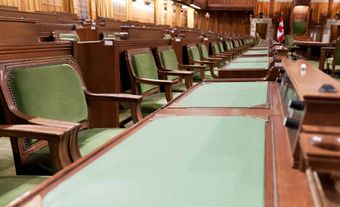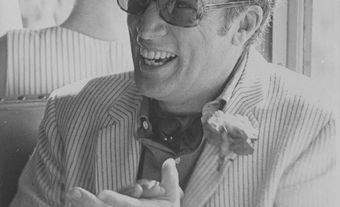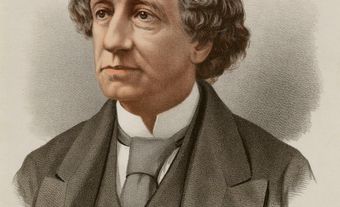The Conservative Party was the founding political party of Canada, governing for the first 29 years after Confederation. Since then, the party has not been as electorally successful as its rival Liberals. The Conservatives have had periods in power and long periods in opposition. The party has been most successful when it was able to assemble a national coalition of anglophone conservatives from the West and Ontario, and nationalists from Quebec. The party is currently led by Pierre Poilievre.

John A. Macdonald
The Conservative Party in Canada took its values and traditions from its namesake in Britain. In the 19th Century, British Conservatives, also known as Tories, were loyal to the monarchy and the Church of England; they generally believed in upholding tradition rather than embracing change. (See Conservatism.) Canadian Conservatives were also influenced by other political strains. One of the earliest was Liberal influences during the 1854 Liberal-Conservative coalition that governed the Province of Canada.
John A. Macdonald entered the 1854 coalition as a moderate Conservative. He shaped the Liberal-Conservative Party that pioneered Confederation. As Canada's first prime minister, Macdonald constructed a party committed to Confederation and to a policy of national economic development. (See National Policy.) The party's hyphenated name symbolized Macdonald's belief in equilibrium and moderation. It also emphasized what Canadians held in common while obscuring matters where they were divided. Macdonald managed to bring together, under a single party, ultramontane Roman Catholics from Quebec, Tories, Orangemen and businessmen from all four founding provinces. By 1872, however, the many parts of the expanding nation had become too different to patch together. That year, Macdonald's Conservatives won 103 seats to 97 for the opposition Liberals. However, his majority did not hold; his government fell in 1873.
The Pacific Scandal that brought down Macdonald's government indicated the problems of his approach. The Canadian Pacific Railway was essential to his nation-building dream; however, its construction — and similar development policies — linked the government too closely with private interests that did not always serve the public interest. In opposition, Macdonald became convinced that his party should represent something more than simply the support of Canada. By then the party had dropped the Liberal-Conservative label in favour of Conservative.

In the 1878 election campaign, Macdonald committed his party to the National Policy. It emphasized trade protectionism, expansion in the West and an assertive central government. (See also Federalism in Canada.) This appealed to Ontario and Quebec manufacturers and to those who feared United States expansionism. (See Manifest Destiny.) A strong pro-British message was added to the Conservative platform. The effectiveness of this approach was proven by Macdonald's re-election in 1882, 1887 and 1891.
Macdonald complemented the National Policy with shrewd and lavish patronage and a willingness to compromise — although compromise evaded him in the case of Louis Riel after the 1885 North-West Rebellion. Riel's execution, along with weak leadership among Quebec Conservatives, led to a decline in support there. Macdonald's reaction to Riel followed from his centralist perspective, which kept provinces and local interests in the background. The result was that the provinces became increasingly Liberal and supported the provincial-rights stand of Liberal leader Wilfrid Laurier.
After Macdonald's death in 1891, his party could not endure attacks on so many fronts. The Conservative governments of John Abbott, John Thompson, Mackenzie Bowell and Charles Tupper struggled to maintain supremacy. Language and religious problems (see Manitoba Schools Question) and patronage issues in Quebec proved to be great obstacles. The Conservatives lost the 1896 election. They did not regain their pre-eminence for many years.
Robert Borden
Nova Scotia lawyer Robert Borden led the federal Conservatives from 1901 to 1920. He sought to push the party beyond Macdonald’s legacy. He experimented with a Quebec lieutenant and advocated civil service reform and public ownership. He lost the elections of 1904 and 1908. To win in 1911, Borden returned to the Conservatives' roots; he emphasized the National Policy and the imperial connection. This won the party support in Ontario, British Columbia and parts of the Maritimes.
In Quebec, the Conservatives allied themselves with anti-Laurier francophone nationalists. The Conservatives won the election, but the imperialist-nationalist coalition collapsed. By 1913, nationalists in Borden’s caucus were bitterly disillusioned with his siding with the more numerous anglophone imperialists, who were eager to support Britain and the Empire.
The 1917 wartime election was critical for Canadian Conservatism. To ensure that his conscription policy was upheld, Borden made an alliance with conscriptionist Liberals. The resulting Union Government triumphed, but the victory created lasting resentment among French Canadians. After the First World War, Liberals deserted the coalition. This left the Conservative Party with a narrower base than ever before. In addition, the nationalization of the Grand Trunk and Canadian Northern railways caused the defection of the Montreal business community, probably the party's greatest source of funds.

Arthur Meighen
Arthur Meighen, Borden's successor, immediately tried to shape the remnants of Unionism into Conservatism. In the 1921 election, the Conservatives finished third with 50 seats, behind the Progressive Party and the Liberals. Meighen's support of conscription meant the loss of francophone support. In Western Canada, Progressives identified more readily with Liberals, since they associated Conservatives with the despised National Policy. Meighen served briefly as prime minister in 1926, but a Liberal majority soon returned. (See King-Byng Affair.) Conservatives were too closely linked with Britain at a time when Canada's Britishness — and its status as an imperial Dominion — was disappearing. Nor did Meighen manage to adapt the National Policy to postwar economic conditions.

R.B. Bennett
In 1927, R.B. Bennett, a wealthy Calgary businessman, succeeded Meighen as Conservative leader. In 1930 he won a majority, including 25 Quebec seats. The Great Depression created the climate for Bennett's victory; it also ensured his defeat five years later. Bennett's initial response to the Depression was a characteristically Conservative attempt to protect industry and obtain imperial trade advantages. It did not work. In 1935 he changed course and called for many social reforms to help poor and struggling Canadians. However, these proposals came too late to be convincing. (See Bennett's New Deal.) Many reformist Conservatives had already left to join the Reconstruction Party founded by former Bennett minister Henry Stevens. Two new parties on the political right and the left — Social Credit and the Co-operative Commonwealth Federation (CCF) — also appealed to English Canada. The 1935 election brought about the worst Conservative defeat to that date; the party took only 40 seats against the Liberals' 173.
The Conservatives struggled to rebuild a successful coalition. The anger of French Canada endured, even though in 1938 the party chose as its leader Robert J. Manion. He had opposed conscription, was Catholic and had married a French Canadian. His attempts to conciliate Quebec only angered anglophone colleagues, now that the Second World War had begun. Party funds were depleted, and the organization atrophied. In 1940, the Conservatives again won only 40 seats. Manion's defeat turned the party back towards Arthur Meighen — again without success.

Progressive Conservative Party (PC)
Encouraged by Arthur Meighen, Manitoba premier John Bracken, a Progressive Party member with no Conservative experience, sought and won the 1942 Conservative leadership. The organization's name was changed to the Progressive Conservative Party (PC). It attempted to shift left; however, the CCF and the Liberals were also moving left.
In 1944, the Conservatives were caught up again in the Second World War pro-conscription movement. Although Liberal prime minister William Lyon Mackenzie King had brought in conscription, the Conservatives' enthusiasm for it ensured that they would bear the blame. In the 1945 election, they could not even find candidates for most Quebec ridings. Meanwhile on the Prairies, the PCs came fourth, behind the CCF, Liberals and Social Credit.

John Diefenbaker
With their poor showings in the West and in Quebec, the PCs were becoming an Ontario party. In 1948, former Ontario premier George Drew was chosen as leader. Drew was unable to broaden the party's appeal. After two disastrous defeats in 1949 and 1953, the party decided to gamble on John Diefenbaker. He was a westerner, a populist and a remarkable showman. Diefenbaker offered both fiery leadership and a visionary program. He excited Canadians, lulled as they were by two decades of Liberal administration. In 1957, Diefenbaker won a minority. The next year, he astonished Canadians by winning 208 out of 265 seats, including 50 from Quebec. (See Elections of 1957 and 1958.) For the first time since 1911, the Conservatives were truly a national party.
Despite strong Quebec support, Diefenbaker could not come to terms with Canada's bicultural nature. His policy initiatives seemed eclectic rather than parts of a larger vision. In 1962, Diefenbaker lost his majority. In 1963, his government fell to the Liberals. His populism had lost much business support, and it now lacked support generally, especially in urban areas. Once again, French Canada shunned the PCs. Diefenbaker's forced removal as leader in September 1967 damaged party unity. His successor, former Nova Scotia Premier Robert Stanfield, was left to try to heal the wounds.
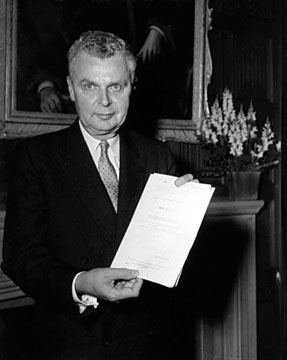
Joe Clark
The PCs had enduring support in Western Canada and considerable provincial-level popularity. This was especially true in Ontario, where the party was in power from 1943 to 1985. By 1979, provincial PC wings were governing in Ontario, Manitoba, Alberta, Nova Scotia, Prince Edward Island, New Brunswick and Newfoundland. In spite of this national appeal, Stanfield was unable to lead the federal party to power. In 1972, he came within three seats of defeating Liberal prime minister Pierre Trudeau.
In 1976, Joe Clark, an Albertan, became federal PC leader. In May 1979, Clark led the PCs to a minority government. However, they were defeated in the House of Commons in December and lost the February 1980 election. (See Elections of 1979 and 1980.)

Brian Mulroney
The 1980 defeat brought Joe Clark’s leadership into question. In 1983, the party rejected Clark and chose the bilingual Quebecer Brian Mulroney as its leader. Although Mulroney lacked any parliamentary experience, he possessed superb organizational skills and a deep knowledge of his native province. The PCs, so often fractious, united behind the new leader as he faced Liberal prime minister Pierre Trudeau’s successor, John Turner, in the 1984 federal election. Mulroney took the western base of the party and fused it with a renewed support among Quebec nationalists who were disillusioned with Trudeau's federalism. The PCs won the largest landslide majority in Canadian history, winning 50 per cent of the popular vote and 211 of 282 seats, including 58 of 75 ridings in Quebec.
Although plagued by ministerial resignations and scandals, the Mulroney Conservatives implemented much of their business agenda. They privatized crown corporations and arranged a free trade deal with the United States. (See NAFTA.) Nevertheless, the failure to achieve its goal of a new federalism through constitutional negotiations (see Meech Lake Accord; Charlottetown Accord), and an inability to reduce the public debt or raise Canada out of a persistent recession, eroded the party's support in its second term. Mulroney's personal popularity fell to lower levels than for any previous prime minister.

Splintering of the Party
The Progressive Conservatives began to splinter under Mulroney in the late 1980s. In 1987, Preston Manning formed the right-wing, populist Reform Party under the general slogan “The West wants in.” Manning led the party to a respectable showing in Alberta in the 1988 election. Weaknesses in Quebec also emerged when Mulroney's friend and Cabinet colleague Lucien Bouchard resigned in disagreement over proposed changes to the Meech Lake Accord. Several Conservative MPs from Quebec followed him; they formed another new party, the Bloc Québecois.
In 1993, the Mulroney coalition disintegrated under the new PC leader and Prime Minister Kim Campbell. She was unable to distance herself from the previous Mulroney regime. Quebec supporters turned to Lucien Bouchard and the Bloc Québécois. Western supporters turned to the Reform Party. The election resulted in the most devastating defeat in the history of Canadian politics. The PCs won only two seats in the Commons and lost official party status.

In 1995, Jean Charest became the first French Canadian ever to head the Conservatives. The youthful Charest was seen as the key to rebuilding the party. In the 1997 federal election, the Tories won 20 seats and regained official status in Parliament. Despite this progress, Charest left the federal PCs in 1998 to replace Daniel Johnson as leader of the Quebec Liberal Party. Charest's replacement was Joe Clark, who returned to active politics and easily won the Tory leadership.
In 1999, the United Alternative (UA), a coalition effort begun by the Reform Party, decided to unite the conservative parties to try and make political inroads against the federal Liberals. The PC Party refused to participate in the UA movement. However, the movement continued with the backing of some Ontario PC members and a handful of Toronto businesspeople.
Meanwhile, the Canadian Alliance was formed in 2000 with former Alberta treasurer Stockwell Day as its leader. In that year's election, Day led the party to 66 seats; Clark's PCs barely held on to official party status with 12 seats — mostly in Atlantic Canada. Clark's strategy of rebuilding the PCs on the base of a crumbling Canadian Alliance had failed.

Conservative Party of Canada
In May 2000, the PCs chose Peter MacKay as their new leader. MacKay won the job by vowing not to pursue a merger with the Canadian Alliance. Weeks later, he broke his promise and entered into merger talks with the Alliance, by this time under the leadership of Stephen Harper. A merger agreement was reached; it was ratified overwhelmingly in December 2003 in separate votes by the memberships of both parties. The amalgamated Conservative Party of Canada came into existence in December 2003. Harper was elected as its first leader the following year.
Provincial Progressive Conservative parties, many of them still competitive in various provinces, maintained the PC brand; but they tended to support the new Conservative Party federally.
The federal merger was bitterly opposed in some quarters, especially among traditional Tory Conservatives. Joe Clark and other PC MPs left the party. They believed the merger was less a union of equals than a takeover by the Canadian Alliance. The decision to drop the term “Progressive” from the party name was viewed as more than symbolic; to some, the new Conservative Party of Canada (CPC) seemed more like the American Republicans than the traditional Tories.

Stephen Harper
The political right-wing was united for the first time in a decade. In the 2004 election, the Conservatives took 99 seats, including important victories in vote-rich Ontario — enough for official opposition status.
Late the following year, the minority Liberal government fell. Harper led the Conservatives to a minority government victory in the 2006 election. Many observers viewed the results as the start of a long-term shift in political power to the Western provinces, especially Alberta, Harper's electoral home.
Harper's government continued Canada's combat mission in Afghanistan; cut taxes; scuttled Canada's support for the Kyoto Protocol on global warming; and pursued Senate reform. It also passed a law creating fixed future election dates. Meanwhile, the Harper regime was criticized for being overly confrontational and partisan in dealing with other parties in the House of Commons, as well as secretive and controlling in its dealings with the media.

In the summer of 2008, Harper ignored his own fixed-date election law and called an election for October. The Conservatives were re-elected with a second minority government. They held onto power through a failed bid by the opposition parties, in the wake of the election, to form a Liberal-New Democrat coalition government supported by the Bloc Québecois.
In their second term, the Harper Conservatives were forced to respond to the recession brought about by the 2008 global financial crisis. Massive economic stimulus spending was announced, including a multi-billion-dollar bailout of the auto industry. This created large federal deficits. The Conservatives also advanced “tough on crime” measures and targeted tax breaks, and ended the mandatory long form census.
In 2011, the Conservatives were found in contempt of Parliament for refusing to provide cost estimates on various programs. As a result, they were defeated on a non-confidence vote, which led to a federal election. The Conservatives campaigned on a platform of economic stability in uncertain times. In May, the party emerged with its long-sought majority, winning 166 of 308 seats. Harper appeared in good position to advance the cause of embedding conservative principles and policies at the heart of Canada's political system.
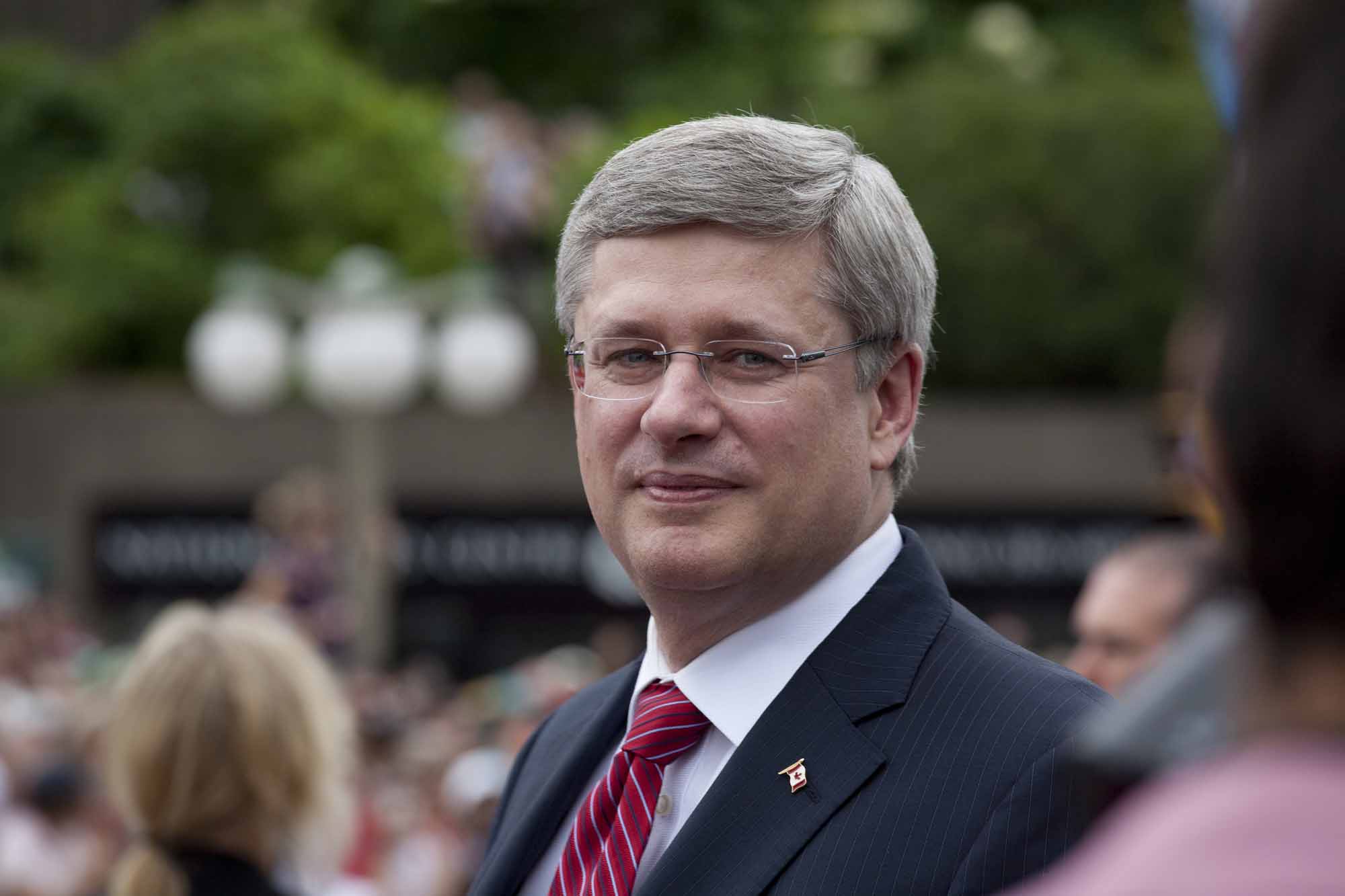
2011 Mandate
Although secure in power for the first time, the Conservative government weathered a series of scandals and bad news. Primarily, it faced allegations of mismanagement in its handling of new military fighter jet procurement. In 2012, an expenses scandal also erupted around a number of high-profile Conservative and Liberal senators. This embroiled the Prime Minister's Office and led to the resignation of its chief of staff. Finance Minister Jim Flaherty, a respected Conservative stalwart from Ontario, resigned in 2014 and died shortly thereafter.
The party was also embroiled in a series of election scandals. In the fall of 2011, the Conservatives pleaded guilty to illegal tactics in the 2006 campaign. (They exceeded advertising limits by shifting national ad expenses onto local riding campaign accounts.) In 2014, a former party staffer was convicted for his role in using a Conservative database to misdirect potential opposition voters in one Ontario riding to the wrong polling stations in the 2011 election.
Meanwhile, the Conservatives continued to deliver deficits, as they had following the 2008–09 financial crisis. This included both tax cuts, and the entrenchment of many of the nominal spending increases instituted during the recession years. A major exception was government spending on defence; it stagnated after the withdrawal of Canadian combat troops from Afghanistan in July 2011.
2015 Defeat
By mid-2015, the CPC was in full campaign mode, preparing for an October election. Support remained weak in Quebec, but the Conservatives had succeeded in appealing to important groups of voters once loyal to the Liberals. These included suburban Canadians in southern Ontario, and immigrant communities of all kinds.
For the first time in decades, however, questions were being raised about a possible voting shift among core Conservative loyalists in the West; especially in Alberta, where 44 years of PC government had been brought to an end by an NDP majority victory in the provincial election in May 2015. The Canadian economy was stagnating and the Alberta oil industry was experiencing deep cuts as a result of low worldwide oil and commodity prices. It was difficult to predict whether the federal Conservatives' claim — that they were the country's best economic stewards — would convince Canadians to give them a fourth national mandate.
The federal election in October revealed that after nine years of Stephen Harper's rule, despite a final return to balanced budgets, Canadians were ready for change. The Liberals under Justin Trudeau won a majority government. They defeated the Conservatives, who returned to the status of official opposition in the House of Commons. Harper resigned as Conservative leader. Former cabinet minister Rona Ambrose became interim party leader.
2016 Leadership Contest
The race to replace Stephen Harper began in earnest in 2016. The leadership vote was scheduled for May 2017. In April 2016, Kellie Leitch, former Minister of Labour and Minister of Status of Women, was the first to launch her leadership campaign. Ultimately, 14 candidates appeared on the ballot, including Andrew Scheer, former Speaker of the House of Commons; Maxime Bernier, former Minister of Foreign Affairs and Minister of Industry; Erin O’Toole, former Minister of Veterans Affairs; and Member of Parliament Brad Trost. Television personality and businessman Kevin O’Leary joined the leadership contest in January 2017. He withdrew before the May vote, despite multiple polls that indicated he was a front runner.
Major issues in the leadership campaign included continuity with the core values of the previous Conservative government; the role of social conservatives in the party; and issues of supply management and immigration. Bernier, who was neck and neck with O’Leary in April, sought to take the party in a more libertarian direction. Leitch drew heavy criticism for suggesting that immigrants to Canada should face screening for “anti-Canadian values.” Scheer, a social conservative, promised to continue the policies of the Conservative government under Harper.
On 27 May 2017, Scheer was elected leader. He defeated Bernier after all other candidates had dropped off in the party’s ranked ballot system. It was a narrow victory — Scheer took 50.95 per cent of the available points under the rules of the balloting system; he defeated Bernier by a count of 62,593 votes to 55,544. Scheer’s election demonstrated the strength of social conservatives in the Conservative Party. He was widely seen as a safer choice than Bernier.
In August 2018, Bernier quit the Conservative caucus. He called the party “morally corrupt” and said that it had abandoned its principles. Bernier founded a new party, the People’s Party of Canada, and announced a plan to run a full slate of candidates in the 2019 federal election. Scheer and other Conservative MPs accused Bernier of putting his personal profile ahead of the party.
Official Opposition, 2015–Present
As the Official Opposition, the Conservatives focused most of their criticism on Prime Minister Justin Trudeau. The party and its provincial allies were particularly critical of Trudeau’s introduction of the carbon tax. Federal Conservatives vowed to repeal the tax if elected in October 2019. The Conservatives also accused Trudeau of mishandling the purchase and construction of the Trans Mountain Pipeline Expansion Project and failing to stand up to US president Donald Trump in trade negotiations. (See Canada and NAFTA.) They also protested Trudeau’s decision to compensate Omar Khadr.
Throughout 2019, much of the Conservatives’ criticism focused on Trudeau’s role in the SNC-Lavalin affair. Conservative leaders accused Trudeau of political interference in the case. They called for broader inquiries by the Ethics Commissioner and RCMP. The party also released a series of platform documents and vision statements in advance of the 2019 general election. In September 2019, it became the first party to announce a full slate of candidates.

2019 Federal Election
The Conservatives won 121 seats in the federal election held on 21 October 2019. The party increased its presence in the House of Commons and won the popular vote; it received over 34 per cent compared to the Liberals at 33 per cent. Support for the Conservatives rose in most provinces, particularly in Saskatchewan, Alberta and Manitoba. However, this was not the case in Quebec and Ontario. Significantly, the Liberals captured most ridings in the Greater Toronto Area, as they had in 2015. The Conservative share of the vote dropped in that region. Overall, the Liberals won 157 seats, enough to give them a minority government. The Conservative Party remained the Official Opposition.
2020 Leadership Contest
Immediately following the 2019 election, Andrew Scheer faced criticism from within his party for failing to unseat Prime Minister Justin Trudeau. Many saw the Liberal leader as extremely vulnerable following the SNC-Lavalin affair. This was compounded by revelations during the campaign that Trudeau had worn blackface on more than one occasion. Peter MacKay said that Scheer’s election loss was “like having a breakaway on an open net and missing the net.” Calls for Scheer’s resignation intensified. On 12 December, he announced that he would step down. He remained as leader until a leadership convention was held; it was scheduled for 27 June 2020.
The leadership was contested by four candidates: Peter MacKay, Erin O’Toole, backbencher Derek Sloan and Toronto lawyer Leslyn Lewis. Sloan had become the first Seventh Day Adventist to be elected to the House of Commons when he was elected to the Ontario riding of Hastings—Lennox and Addington in the 2019 election. He quickly marginalized himself with comments that were widely seen as racist and homophobic. The unilingual Lewis sought to reopen the debate on abortion. She also became the first Black woman to run for the leadership of the Conservative Party.
The contest effectively became a two-person race between MacKay and O’Toole. Due to the COVID-19 pandemic, the convention was postponed and the voting was conducted by mail. More than 170,000 ballots were cast, and the results were delayed for several hours due to a malfunction with a mail-sorting machine. On 23 August, O’Toole was named leader of the CPC after winning 57 per cent of the vote on the third ballot.


 Share on Facebook
Share on Facebook Share on X
Share on X Share by Email
Share by Email Share on Google Classroom
Share on Google Classroom





